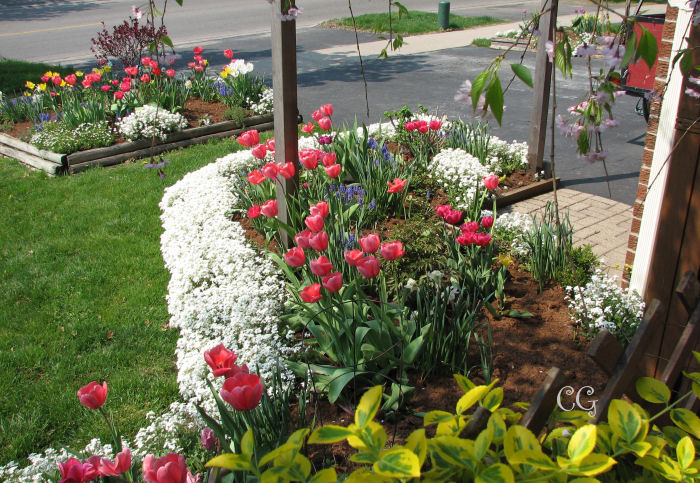How to Grow Flowers
Bulbs, Tubers and Corms

How to Grow Spring Bulbs, Tubers and Corms - Hello Spring! :
Last Fall I started some spring bulbs in the house and they are in bloom right now. (January 23 )
How to make wire mesh bulb baskets at my other website.
If Moles are a problem in your yard - I found using 1/4" hardware cloth for the bottom of the box and 1/2" mesh for the lid - works.
Sometimes just a piece of chickenwire fencing is enough to deter hungry squirrels and chipmunks from eating my bulbs.
Buying Bulbs:
When buying bulbs, make sure they feel firm, solid and heavy for its size.
Not dried out or moldy, even if you have to open the bag in the parking lot.
Spring Flowering Bulbs and when to plant them:
Most spring bulbs need at least a 12-15 week period of cold temperatures and darkness to give them time to grow healthy roots. The bulbs must have enough time to grow roots before being exposed to freezing temperatures. It amazes me that they are not all mashed bulbs in the spring.
Summer Flowering Bulbs
This group of bulbs provide reliable colour from summer to frost. They are cold-hardy and tender bulbs. Lilies can be left in place all year, but tender bulbs like dahlias, tuber begonias, gladioli, have to be dug-up and stored indoors for the winter.
How many plants should I plant together:
I like to mass plant bulbs like: dig a trench and dump all the bulbs in. Straighten them pointy side up. Cover with chicken wire, add soil, mulch, water, some bone meal and say " see you next spring!".
If I only bought a small quantity - I do bunches of 3's, 5's or 7's.
I think grouping of 7 looks best.
Are all Spring Blooming Bulbs Perennial.
No! Not in Zone6. Paperwhites won't come back and neither will Amaryllis.
Although they are nice bulbs for forcing indoors.
Right now I have Hyacinths and Amaryllis blooming indoors. One year I had Paperwhites, Tulips, Daffodils and Crocuses. The ones that I have more success with are Amaryllis and Hyacinths.
Can you plant bedding plants on top of bulbs:
Yes! I like to plants grasses, ferns and annuals over them. If I can find them. I always cover my bulbs with hardware cloth or chicken wire. The chicken wire protects my bulbs from the Kritters and I won't be spearing my bulbs with the garden fork.
Best Fertilizer for Bulbs and buying Healthy bulbs:
I use Bone Meal for a fertilizer.
Compost and Bone Meal on new planted bulbs. I also give my old bulbs a little bit of Bone Meal when they start blooming.
Bulbs:
Tulips, Hyacinths, daffodils, lilies, onions and garlic are true bulbs.
True bulbs consists of layers of scales designed to store food for the plant over the winter.
Also true bulbs have pointed tips which makes it easier to determine which side is up before planting. The roots come from the the basal plate at the flat bottom of the bulbs.
Landscaping with spring bulbs at H-n-G
Tubers:
Tubers are underground stems that have buds (eyes) and take many forms.
Roots grow out of the sides, the bottom and sometimes the top.
Tuberous begonias and anemones arises from tuber-corms often flat tubers with a lumpy appearance.
Tuberous Roots:
Tuberous roots are round and fleshy and often with a pointed bud on top. Dahlias are probably the best known that sprouts from tuberous roots.
Corms:
At the first glance some corms look like true bulbs. The biggest difference is that corm is a chunk of stored food not like a true bulb that are layers of papery skin. At the top of the corm there is a pointy tip or bud from which flowers and leaves will sprout. Two corms that come to my mind are crocuses and gladioli.
Caring for Tubers, Corms and Bulbs:
Bulbs are a storage system with a fat underground root.
Bulbs have all they need to survive, programmed with an inner clock to sleep until the warm rain comes. The plant will bloom, the flower will die and the leaves will continue feeding the bulb for next year.
Deadheading:
I like to do this, because it keeps the garden looking tidy.
Also I want my plants energy to go into producing food for next years flowers and not into producing seeds.
Propagating Bulbs:
I did this with snowdrops one year.
I don't know how successful it was. I only had a few and I wanted more and I couldn't find any to buy.
So, I sterilized everything and just cut my snowdrop in half and planted the bulb as usual.
Took a couples years for those little bulbs to bloom.
Propagating lilies are easier:
Before I plant them I remove some of the lily scales from the mother bulb.
Then I just put the scales in soil and grow them until they are big enough to plant them outdoors.
Tip: Squirrels, Mice, Chipmunks like bulbs. I always cover all of my bulbs with hardware cloth or chicken wire.
Bulb Planters - are they a useless tool?
All about Flowers
Flower Gardening
Table of Contents
more Reading
- Perennial Gardening
- Growing Food
- Growing Herbs
- Gardening for Birds
- Landscaping for Butterflies
- Landscaping for Hummingbirds
- Spring Bulbs - Tubers - Corms
- Container Gardening
- Flower Gardening
- Gifts from the garden
- Homemade Pesticide & Herbicide
- Forcing Spring Bulbs to Bloom Indoors
- Seed Packet Templates
- Seeds - Harvesting, Drying & Storing
- Infusing Oils & Vinegars
- Printable Templates
- Photo Gallery